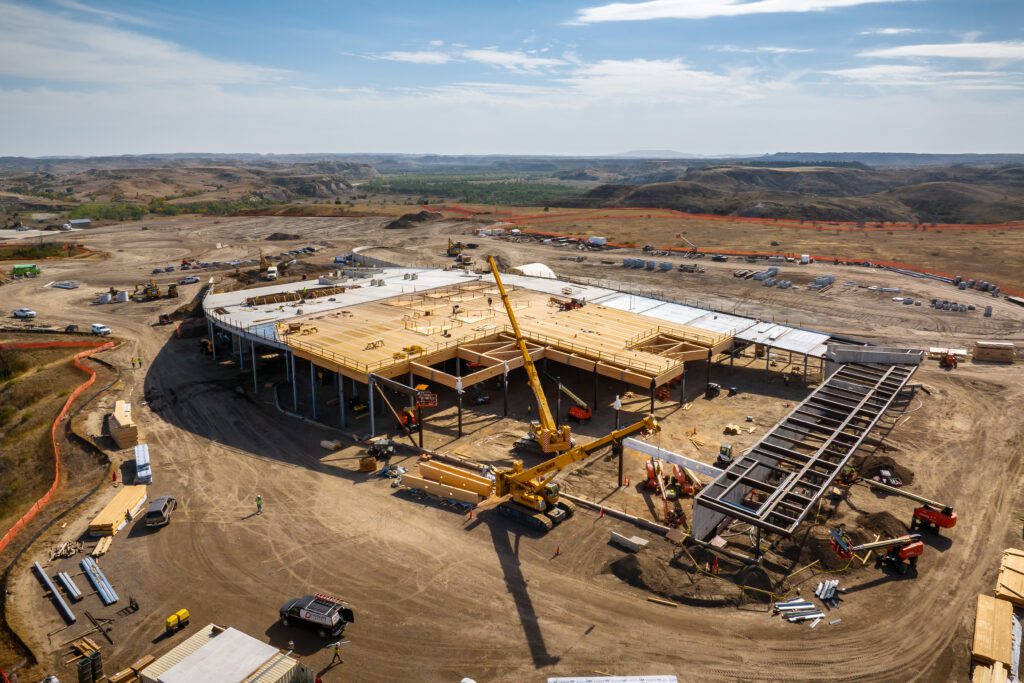Let’s face it, the construction industry doesn’t have the greenest reputation – and with good reason, too. Buildings are responsible for nearly 40% of global carbon dioxide emissions, with 28% stemming from operations and 11% from construction materials, per the World Green Building Council.
The main culprits? Steel and concrete.
As the Earth gets progressively warmer and more densely populated, the urgency to adopt sustainable construction materials has become paramount. That’s where mass timber — the construction alternative that’s gaining momentum worldwide — comes into play.

The Power of Wood
Renowned for its durability and ability to sequester carbon dioxide, mass timber has many properties and benefits that make it a promising natural, renewable solution for next-generation low carbon building.
So, what makes it such a viable and sustainable construction solution? And what role does it play in meeting environmental needs?
Carbon Capture Champion
Put simply, a key feature of mass timber is carbon sequestration, which essentially refers to timber’s ability to capture and store carbon from the atmosphere, acting as a ‘carbon sink’.
On top of mass timber’s active role in storing carbon dioxide, it also plays a passive role in boosting sustainability, slicing energy consumption through:
- Resource reduction: Compared to traditional materials, mass timber requires significantly less water and energy, which directly translates to a lower embodied carbon footprint, minimizing environmental impact from the get go.
- Operational efficiency: Prefabrication techniques in mass timber construction enable on-site assembly for streamlined operations. This means less on-site works, less machinery, and less construction traffic, thereby reducing negative impact on the surrounding environment.
But what about the material’s longevity? Well, not only is timber reusable, it has an extended lifespan, killing two birds with one stone by maximizing resource efficiency, while also eliminating landfill waste.

Prepared for Extreme Weather and Natural Disasters
From high winds to hurricanes, the U.S. has seen a surge in extreme weather, escalating in both frequency and severity. This rapidly changing climate has called for stronger building foundations that can handle the powerful forces of nature.
With an unparalleled strength-to-weight ratio, mass timber (though lightweight) is not easily swayed. It’s fit to withstand the intense huffs, puffs, and quakes that threaten the integrity of many city buildings. With excellent strength as well as ductility, the wood can also effectively absorb and dissipate seismic energy, making for a reliable building foundation.
Its durability hasn’t gone unnoticed either. In fact, its qualities have been acknowledged by regulatory authorities, receiving formal approval as a sustainable construction material for mid-rise city buildings, as per the International Building Code (IBC).
Smashing Stereotypes on Fire Resistance
It’s natural to make the common assumption: Wood = fire.
But, while this may apply to untreated, dead wood, mass timber busts the myth that ‘all wood catches easily’. In fact, there are many ways in which mass timber effectively resists fire. Just to name a few, it:
- Undergoes slow and predictable combustion: When subject to fire, mass timber burns formulaically over a long period of time, which brings increased stability to fire safety measures and facilitates well-organised evacuation procedures.
- Forms a protective layer of char: This insulates the inner layers, slowing down the spread of fire, and acts as a barrier, preventing flames from reaching deeper structural elements.
- Withstands intense heat: Mass timber products like CLT have large cross-sections which offer significant mass that resists heat penetration for long periods of time.
- Maintains stability after a fire takes place: The dimensions of each mass timber component can be strategically designed using a predictable charring rate, to ensure that the load-carrying capacity remains uncompromised in the event of a fire.
- Can be encased in non-combustible materials: Taking fire safety a step further, engineered fire protection solutions mean mass timber can gain an additional layer of protection, ensuring it meets stringent building codes.

A Sustainable Construction Solution Growing Under Our Noses
It can be tempting to think of construction as a ‘local’ issue. But sourcing the required materials often depends on a complex web of global supply chains – spanning from Asia to Africa and beyond.
To see how this impacts sustainability, consider the example of steel. Typically, steel is mined in Australia or Brazil, and gets shipped thousands of miles to China for steel production, namely in the famous Hebei, Jiangsu, and Shandong regions. The steel is then shipped across the pacific ocean to the U.S. for storage, distribution, and construction. The carbon footprint from travel alone is astronomical. Fortunately, mass timber offers a local construction solution.
Home to some of the nation’s most productive forests, the Pacific Northwest is currently paving the way in sustainable forestry and mass timber innovation. And New England doesn’t fall far behind. Its Forestry Foundation has put plans in place to absorb carbon dioxide through productive forests, offering additional sustainable supply chain opportunities within the U.S.
By using locally grown materials, less transportation is required, eliminating the harmful carbon emissions produced from international shipping. Moreover, as timber’s popularity continues to grow, landowners are likely to start adopting timber as a ‘crop’, creating tree farms and supporting a plant-grow-cut cycle that combats deforestation.

Towers of Timber: The Future of Cities
Compared to its finite counterparts, mass timber emerges as an accessible cornerstone for modern building. No longer is mass timber ‘just an alternative’, it’s a sustainable imperative that directly contributes to a green future in construction.
Beyond residential spaces, it’s no secret that more housing is needed in cities. Mass timbers’ adaptability, strength, and efficiency provides an ideal solution to offer this quickly, affordably, and sustainably. With mass timber city buildings now reaching record-breaking heights, this construction resource holds the power to steer urban landscapes toward a sustainable, resilient, and ecologically conscious future.
Could this be a sign of things to come?

